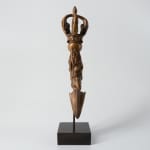Tibetan Phurba, Eighteenth to Nineteenth Century AD
Bronze
26 x 6.2 x 7 cm
10 1/4 x 2 1/2 x 2 3/4 in
10 1/4 x 2 1/2 x 2 3/4 in
ES.0465
Further images
The phurba is a three-sided ritual dagger or stake, patterned after an ancient peg used to tether sacrificial animals, or after the pegs that secured the guy-ropes of tents. The...
The phurba is a three-sided ritual dagger or stake, patterned after an ancient peg used to tether sacrificial animals, or after the pegs that secured the guy-ropes of tents. The three blades, and the three elements of the phurba itself, represent the three spirit worlds of Himalayan Buddhism; the phurba overall signifies the world-axis, the bringing together of the three spiritual realms. As a dagger, it represents the destruction of the spiritual foe or obstruction. As such, it is used against evil spirits by the tantric practitioner. Spirits are thought to be confused, non-physical entities who are trapped between realms. By plunging the phurba into them, the Vedic Buddhist practitioner resolves the spirit’s confusion, and gives it the opportunity to be reborn in one of the three realms.
The top portion or pommel of this phurba takes the form of a ribbed spherical head, joined together with a teardrop shape. This pattern is borrowed from the vajra, a ritual club that combines the power of the thunderbolt with the indestructability of diamond. The vajra first appears in Hinduism as the weapon of Indra, the chief of the devas and king of Svarga (heaven). Indra used the vajra to dispense with sinners and non-believers. Later, the vajra is associated with Vajrayana (‘the diamond way’), a major tantric school of Buddhism. Originating in Northern India, Vajrayana spread quickly to Tibet. In tantric Buddhism, the vajra is a symbol of sunyata (‘emptiness’ or ‘voidness’), and is used in many rituals. It is rare to see the vajra combined with the phurba like this. The next element, the handle, shows the mouth of a dragon, from which emerges the head of a lion. The dragon represents a naga, the water spirits of Indian tradition, one of whom was said to have coiled around the sleeping Buddha shortly after his enlightenment, sheltering him from the rain. The lion is an important Buddhist symbol, the protector of the Dharma. The Buddha’s voice is portrayed as the ‘lion’s roar’, proclaiming the Dharma for all to hear. The figures are especially finely cast. The dragon bears almond-shaped eyes, sharp teeth, and a skin rippling with scales. The lion is realistically presented, with a rounded muzzle and elongated feline eyes. From the lion’s mouth emerges the three blades, which converge on a point. The blade is barbed at the top, and curves slightly towards the bottom.
The phurba is a central tool in all the rituals of Himalayan shamanism, and in many aspects of Vedic Buddhism. It is traditionally used to exorcise demons and evil spirits. By tying a spirit to the phurba and then vanquishing them with its point, it is a means to destroy violence, hatred and aggression. Similarly, the restless spirits of a place may be calmed by driving multiple phurbas into the ground, and tying a thread between them, thereby creating a spiritual circle. This is essential before any shamanistic or Vedic ritual can take place there. In the valleys of the Himalayas, where the practices of Buddhism, Hinduism and Animism are brought together, the phurba is an important implement in the various mask-dances (cham) which invoke protector deities and disperse negative energies.
The top portion or pommel of this phurba takes the form of a ribbed spherical head, joined together with a teardrop shape. This pattern is borrowed from the vajra, a ritual club that combines the power of the thunderbolt with the indestructability of diamond. The vajra first appears in Hinduism as the weapon of Indra, the chief of the devas and king of Svarga (heaven). Indra used the vajra to dispense with sinners and non-believers. Later, the vajra is associated with Vajrayana (‘the diamond way’), a major tantric school of Buddhism. Originating in Northern India, Vajrayana spread quickly to Tibet. In tantric Buddhism, the vajra is a symbol of sunyata (‘emptiness’ or ‘voidness’), and is used in many rituals. It is rare to see the vajra combined with the phurba like this. The next element, the handle, shows the mouth of a dragon, from which emerges the head of a lion. The dragon represents a naga, the water spirits of Indian tradition, one of whom was said to have coiled around the sleeping Buddha shortly after his enlightenment, sheltering him from the rain. The lion is an important Buddhist symbol, the protector of the Dharma. The Buddha’s voice is portrayed as the ‘lion’s roar’, proclaiming the Dharma for all to hear. The figures are especially finely cast. The dragon bears almond-shaped eyes, sharp teeth, and a skin rippling with scales. The lion is realistically presented, with a rounded muzzle and elongated feline eyes. From the lion’s mouth emerges the three blades, which converge on a point. The blade is barbed at the top, and curves slightly towards the bottom.
The phurba is a central tool in all the rituals of Himalayan shamanism, and in many aspects of Vedic Buddhism. It is traditionally used to exorcise demons and evil spirits. By tying a spirit to the phurba and then vanquishing them with its point, it is a means to destroy violence, hatred and aggression. Similarly, the restless spirits of a place may be calmed by driving multiple phurbas into the ground, and tying a thread between them, thereby creating a spiritual circle. This is essential before any shamanistic or Vedic ritual can take place there. In the valleys of the Himalayas, where the practices of Buddhism, Hinduism and Animism are brought together, the phurba is an important implement in the various mask-dances (cham) which invoke protector deities and disperse negative energies.









